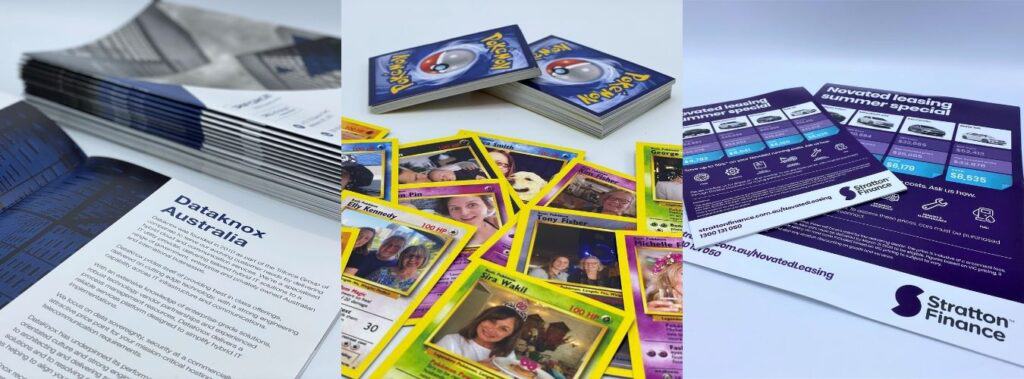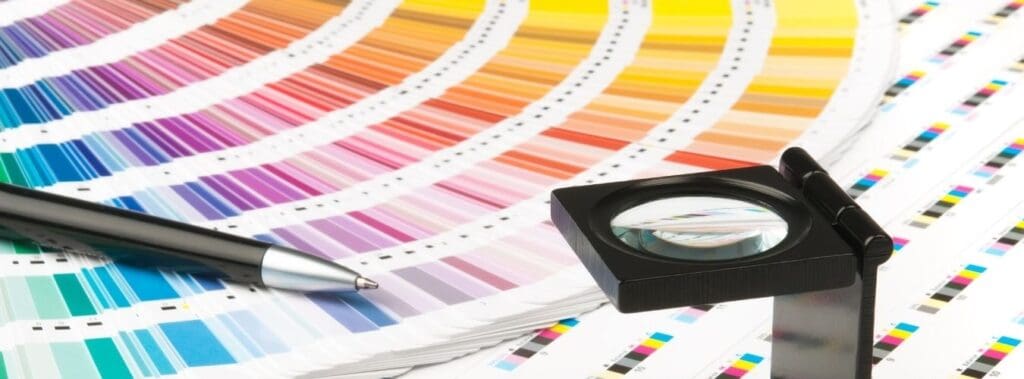Don’t know the differences between digital and litho printing? If that’s the case you have visited the right page. In this blog, we are sharing information you need to know about digital and litho printing. We will answer questions regarding printing inks, paperweights, spot colours, and many more.
Once you have read the below information, you will have a better understanding of each printing type. This allows you to select the best printing process that suits your specific needs. So, whether you are printing flyers, business cards or books, this blog will help you decide which method is best.

What Inks Are Used in Digital and Litho Printing?
The standard 4 colour printing process of Cyan, Magenta, Yellow, and Black (CMYK) is used to create images by both digital and litho printing. But, each printing process needs a different kind of ink. The decision process will be easier for you if you know the key differences between the two.
With litho printing, you need to leave your print to dry before it can be finished. This is because it uses a thick, tacky, and wet ink paste. However, additional methods can be used to speed up the drying process. With this printing style, your job is not completely finished right after printing.
While digital printing uses unique liquid ink that unites the benefits of digital printing while still using quality ink. With this process, your prints are ready to use immediately which gives a quicker turnaround and delivery time.
Are There Any Special Inks Available for Litho and Digital Printing?
Metallic and fluorescent inks are often used for litho printing. However, they are not common with digital printing. At Barney’s Printing, we do offer a wide variety of coloured inks that work great with themed events and branded materials. This is the best printing solution, especially for printing marketing materials.
How Does Digital and Litho Printing Cope With Spot Colors?
Spot colour is perfect when colour consistency and accuracy across the print job is crucial. Below you will see how digital and litho printing helps you match spot colours.
Litho printing traditionally uses specifically combined Pantone color inks to match the colour chart. Normally, you need to pay more if you are using Pantone colour inks rather than CMYK.
Because of technological advancements, Pantone colour reproduction is done using the standard four-colour printing method. With our latest technology, we can match a lot of colours accurately.

Is it Difficult To Set Up Both Digital and Litho Printing?
Litho printing has a setup time where the printing plates need to be created from the print file. While digital presses require minimal setup. We have listed the set-up process for both.
With litho printing, our production team needs to convert your designs into printing plates before they are transferred to the paper. There is a requirement of a minimum of four plates for four-colour presses. The plate picks up the ink and sends it to the printing blanket. That is where it is transferred onto paper. Depending on the size of your print, you may need more than one plate per colour. Additional plates will cost extra, making small to medium prints a very costly option.
On the other hand, digital printing needs no setup. Files ready for printing are sent directly and digitally. Designs can be unique for each page since the artwork is written line by line. They are perfect for small and medium prints, and they are more affordable.
Are Paper Weights and Substrates Different In Digital and Litho Printing?
Here are the differences between digital and litho printing when it comes to paperweights and substrates.
Litho printing has a larger selection of substrates available on a wider range of paperweights from 60gsm to 500 gsm.
Digital printing may not have as much variety but it still offers an impressive range of substrates you can select from. It can accommodate paper weights from 90gsm to 400 gsm.
What Process Offers Better Print Quality?
It is said that litho printing provides better print quality. That said, with new technology advancements, digital printing now offers the same level of quality. Plus, it has a quicker turn-around time and is said to be more affordable.
What Printing Process is Faster?
Litho presses print more A4 sheets per hour compared to digital presses. However, their setup time can add more time to the overall turnaround time. Making digital printing a much faster printing process.
Is Litho Printing More Affordable Than Digital Printing?
The latter is true because there is no minimum for digital print runs. Digital printing is a more cost-effective choice where you only print what you need and when you need it. With litho printing, you need to order in large quantities which entails more cost. When you print small to medium batches, you save more both in time and money.
Which Printing Process Is Better For Personalisation?
Personalised printing can be quite expensive if you are using litho printing. It’s just not practical due to the use and cost of printing plates. While digital printing allows every sheet to have a different print since it prints images line by line. Making it perfect for place names, invites, individual numbering and many more.
Which Printing Process Has A Faster Turnaround Time?
If you need your prints right away, digital printing is the better option. Digital printing has a faster turnaround time compared to litho printing which usually takes 3-5 days.
Which Are More Environment-Friendly?
If you want to do your part for the environment, you should consider digital printing. It allows you only print what you need so there is no wastage. Since litho printing has large print runs, overproduction can be an issue. We recommend using the digital process if you want to print what is needed and prevent unnecessary waste disposal or recycling.
Let’s Sum Up the Differences Between Digital and Litho Printing
Now, you know the key differences between digital and litho printing. After reading the above you should have a much better idea of what printing method is suitable for your project.
- Digital printing is a quicker turnaround time
- Smaller jobs are ideal for digital printing and there is no minimum
- Litho Printing is better for colour matching
- Large quantities is more cost effective with offset litho printing
At Barneys Printing, we help you achieve your prints using our latest technology. With Fast Promos as our sister company, we are a one stop shop! From Promotional Pens to Hand Sanitiser, we have you covered. If you need further details don’t hesitate to contact us on 1300 663 812.
